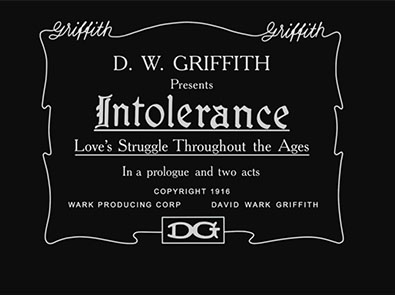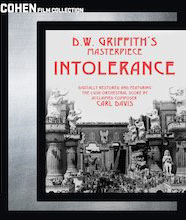
 BUY FROM AMAZON: CLICK HERE!
BUY FROM AMAZON: CLICK HERE!
MSRP $49.98
RATED UR
STUDIO Cohen Media Group
RUNNING TIME 168 Minutes
SPECIAL FEATURES
• Interview with Historian Kevin Brownlow
• Booklet Essays
• 2013 Re-release Trailer
• Full features: The Mother and The Law, and The Fall of Babylon
The Pitch
Like a much quieter, old-timey Cloud Atlas.
The Humans
D.W. Griffith, Lillian Gish, Mae Marsh, Constance Talmadge, Robert Harron

Uh-oh, call the dance police!
The Nutshell
In this cinematic milestone, director D.W. Griffith utilized enormous sets and thousands of extras in order to stage his cinematic exploration of intolerance and its terrible effects throughout history from Ancient Babylon and Biblical Judea to Medieval Paris and Modern America.
The Lowdown
Very few people of my generation watch silent films for pure entertainment alone. We have enough distance from the silent era that they now seem more akin to history lessons, which enhances their value in a certain respect, but can deaden the emotional impact that was originally intended. In order to analyze films, we need to achieve a certain emotional distance, which isn’t difficult for silent films, because there’s a perceived quaintness to them. We have a tendency to look at silent films like macaroni art: cute, but crude. They’re not the complex sensory experiences we are accustomed to getting from contemporary cinema.

I think I’m gonna use this phrase when I hit on women.
D.W. Griffith’s 1915 epic The Birth of a Nation is a film we NEED to have a certain distance from, not just emotionally but culturally, because most of us (I hope) shouldn’t agree with a film that portrays the Ku Klux Klan as valiant heroes. If you went to film school or have taken any film classes, I can guarantee you watched or discussed The Birth of a Nation, and not just because of the controversy surrounding it. It was used as a propaganda film. It was the first film screened in the White House. It was also a huge hit, the kind of box office smash that was unprecedented at the time.
Intolerance is widely considered Griffith’s ‘apology’ for The Birth of a Nation, which sounds odd, because it’s still another white-washed historical epic, it just happens to feature a few actual black people instead of just white actors in blackface. The scope and scale of Intolerance is exponentially larger, though, and the intercutting of several wildly different narratives was something that hadn’t really been done before.
In fact, the concept was so new to audiences in 1916 that Griffith (somewhat apologetically) explained the technique in the opening titles, in hopes that audiences wouldn’t get lost when they saw a sudden cut to ancient Jerusalem or Babylon. This was the Cloud Atlas of its time, except people were even more baffled by it.

Sexism was so adorable back then.
I mentioned earlier that silent films are more like history lessons to us, but in the case of Intolerance that feeling is further enhanced by Griffith’s need to frequently explain what the hell audiences were about to see. He uses frequent intertitles to educate his audience about the characters, themes, and settings. It seems clunky to tell your audience that a character owns four geese and is generally happy by just making the audience read those facts, but early silent filmmakers had no preconceived notion of how to do that using images alone. The technique hadn’t been developed yet. It was a medium in its infancy, so I feel I have to forgive the comparatively clunky exposition.
This exposition is particularly necessary during the Babylon, Jerusalem, and France stories, because Griffith felt audiences should understand the historical context of how and why all of the action was happening. It’s a ton of information, and it became easy to see why audiences didn’t connect with it very easily.
What did connect with audiences were the doe-eyed rubes that served as the main characters in the modern and Babylon stories. The Dear One, played by Mae Marsh, is a simple farm girl whose father works at the Jenkins Mill. Mae Marsh’s performance is equally heart-rending and hilarious, and her range of emotion is impressive. After her father dies, the film uses one of its few extreme closeups to show the emptiness in her eyes as she mourns his passing. She’s wrecked, and her stillness is far more effective at showing her grief than dramatic wailing or eye-dabbing.

How do you want me to do that, exactly?
Just as memorable as Marsh’s Dear One is The Mountain Girl, played by Constance Talmadge. Another unpolished country gem, The Mountain Girl stomps around the the impossibly grandiose Babylon wearing a silly hat, playing with goats, and munching on onions at inappropriate times. She and The Dear One both initially reject male advances, being too comfortable in their unsophisticated hayseed lifestyles. With these two characters, Griffith makes the most of one of comedy’s oldest jokes: the culture clash, the untamed and ungroomed amongst the snobs. Talmadge, her adorable face framed by her ridiculous hat and unkempt curly mop, is truly funny and memorable in her role. With leading ladies like these, It’s no surprise that Babylonian and Modern stories were later re-edited into their own, shorter films (which are featured on the second disc).
The other two stories don’t work as well, and are given a bit less screen time. The crucifixion of Christ seems shoehorned in, and makes the film feel too self-important. Actor Howard Gaye’s portrayal of Christ is performed in the same series of stiff poses we frequently see in Christian art. He just moves from one pose to the next, awkwardly shuffling like a rusted robot. The story of the Huguenots is another instance of oppression and murder by moral puritans, and it has great production value and some shocking pre-code violence, but it is overshadowed by the spectacle of Babylon.

I always pick the worst places to eat onions.
Spectacle, I think, is really how our generation will relate to this film. Armies of hundreds fighting in huge ancient cities is an image we’ve seen frequently in contemporary cinema, but there’s much more illusion to it now. It’s still exciting, but we accept that it is artificial. What shocked me about Intolerance is that the spectacle is real. The set pieces in The Fall of Babylon don’t feature miniatures or digital set extensions. The hundreds of men fighting in the background aren’t put there by artists. The men atop the walls of the city are pouring real burning oil and huge chunks of plaster down onto extras below, and the extras are really having to get the hell out of the way. The cameras of the time weren’t capable of a huge range of focus, so most of the film is shot in deep, deep focus, which allows us to see just how freakin’ HUUUUUUUGE these sets had to be. The scale is real, the spectacle is all there on screen. I think I could count the number of matte paintings I saw in the film on one hand. The effects are practical to the point of egregious impracticality. It’s enormous in a way that many of us just haven’t seen.
It’s in these scenes that the quaintness of silent film begins to melt away. You really want to see a one-of-kind bloated epic, choked with extravagant visual spectacle, violence, and silly humor? Skip The Amazing Spider-Man 2, and saturate your brain with D.W. Griffith’s Intolerance instead. It proves that while silent films may still feel like history lessons, they can still be engaging visual experiences. Intolerance may be an experience you may only want to have once, but if you can stomach silent films, you should stomach this one.

In other words, you fucking stink.
The Package
Re-editing and revision was something that Griffith couldn’t stop himself from doing on Intolerance. Even after the film had been distributed, he was still shooting additional footage and alternate endings. He didn’t want to abandon his film, and this eventually resulted in several versions of the film floating around. The version featured in this Blu-Ray set is the Official Thames Silents Restoration, in which scenes have been re-tinted in sepia, pink, red, blue, and several other colors, which was Griffith’s original intention. The transfer quality is really stunning for a film that is nearly a century old. I couldn’t spot any dirt or tears in the print. All of the jitter has been stabilized, and it doesn’t look terribly under-cranked and sped up. In short, Intolerance looks as close to perfect as it ever will.
The audio is a 5.1 DTS-HD Master Audio score by composer Carl Davis, which sounds beautiful and feels completely faithful to the ever-changing tone of the film. It never sounds uninspired or boring, which is particularly admirable for a silent film with a 168 minute running time.
The extras are, like the other Cohen Collection sets I’ve reviewed, mostly educational. The booklet essays are comprehensive, and chronicle the film’s production. The interview with historian Kevin Brownlow has some interesting anecdotes and facts about the film, so I’d consider that a must-watch. The two separate, re-edited versions of The Mother and The Law and The Fall of Babylon are presented in HD, but the prints aren’t in great shape. They are in untinted black and white, and have smaller musical scores that make them feel more chintzy, but they are still worth a watch for completists.
Rating: 




Out of a Possible 5 Stars